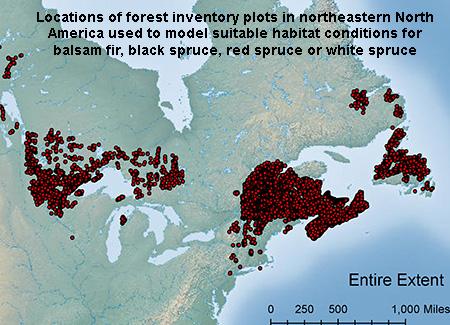Future Distribution and Productivity of Spruce-Fir Forests Under Climate Change: A Comparison of the Northeast and the Lake States

Eastern spruce-fir forests cover five million hectares across the Northeast, Upper Midwest, and Appalachian regions of the U.S. Broad-scale climate models suggest increasing temperatures and changing precipitation patterns will reduce habitat suitability for balsam fir and spruce species (black, red and white). Growth conditions are expected to favor hardwoods and more southerly conifers. Red spruce has been identified as a top ten species to be negatively impacted by climate change in eastern North America. Balsam fir is expected to lose a significant portion of its current range.
Such predictions, however, overlook fine-scale variation in environmental conditions that may promote local persistence, as well as interactions with disturbances, such as timber harvesting or insect outbreaks. To better model suitable habitat for balsam fir and spruce species, NSRC researchers assembled an extensive database of forest inventory plots consisting of more than 10 million observations across the spruce-fir range. They developed bioclimatic envelope models and used a forest landscape model to understand how climate change, harvesting, and spruce budworm will impact spruce-fir forests.
Results suggest that although suitable climate conditions for spruce-fir will decline as a result of less snow and warmer winter temperatures, habitable patches will remain in the Northeast through 2090 for all but white spruce. Ecosystem resilience will help ensure the spruce-fir distribution in Maine remains largely unchanged over at least the next 50 years. Ultimately, broad-scale climate models may overstress climate change effects on northeastern spruce-fir forests over the next century. In this study, timber harvesting had greater impact on future forest composition in Maine than did climate change.
